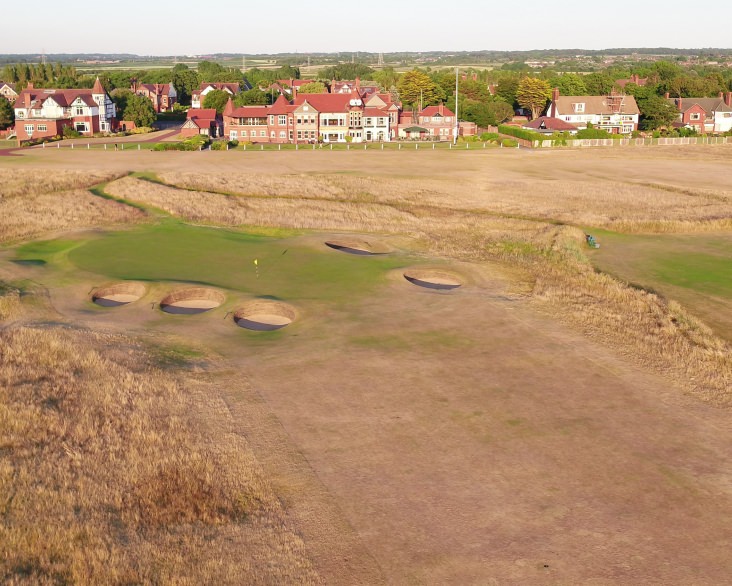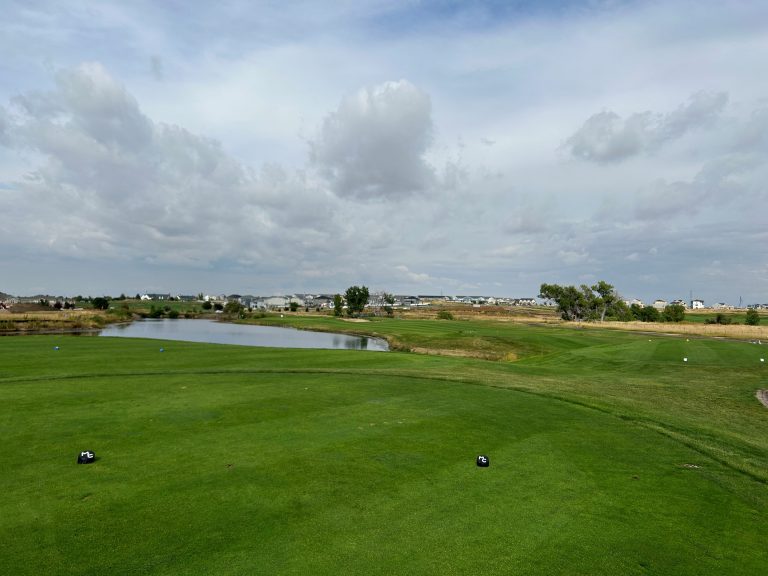Royal Liverpool Golf Club Overview

Home to the 151st Open is one of the oldest and most respected golf clubs in England, the Royal Liverpool Golf Club. You may also hear this club referred to as “Hoylake” and that is because it is located in the town of Hoylake. The golf club is most notably known for its hilly fairways, deep bunkers, and quick greens.
Located on the Wirral Peninsula in Meyerside, England, it is just under 30 minutes West from Liverpool. Established in 1869, the Royal Liverpool Golf Club is the second oldest seaside course in England. Since it is situated right on the sea, you can imagine the breathtaking views all over this course.
At 7,341 yards and a par 72, it is one of the longest courses to host The Open Championship. The course is not your typical “out and back” design, rather it is more circular in nature.
Royal Liverpool Golf Club History
The Liverpool Golf Club was established in 1869, originally as a 9-hole course, and designed by George Morris and Robert Chambers. Two years later, in 1871, 9 more holes were added and the “Royal” designation was granted by The Duke of Connaught. Therefore, the course has been named the Royal Liverpool Golf Club ever since.
Hoylake hosted the first Amateur Championship, the first International golf match, and has hosted The Open Championship 12 times. This cements the fact that Royal Liverpool Golf Club has been crucial to shaping the sport of golf.
In 2001, Martin Hawtree, a famous golf course architect, was hired to redesign the golf club before The Open Championship in 2006. The main reason for this renovation was to make sure the course was up to the expected modern course major championship standards. So Martin lengthened the course, added more vegetation and bunkers, and improved greens. There have also been many other course alterations over the 154-year span, but nothing too major, like the renovation in 2001.
Royal Liverpool Golf Club Sustainability
This is an aspect that the golf club doesn’t take lightly, sustainability. Many golf courses around the world focus in on sustainability when it comes to their course in areas such as water management, habitat protection and creation, reducing chemical use, energy efficiency, and waste management.
Royal Liverpool Golf Club takes this a step further with its “gold is the new green” approach. This is specifically related to its approach in the event of droughts or heat waves. Instead of letting the sprinklers run for hours to maintain lush green grass, Hoylake decides to use water wisely causing the majority of the grass to turn gold. They focus the water usage on high priority areas, such as the greens, tees, and the surrounding areas.
Now these playing conditions do require a new set of skills, bump and runs, tight lies, and more. However, it presents a challenging, yet rewarding, golfing experience.

Credit: Royal Liverpool Golf
Course Overview & Scorecard
The Royal Liverpool Golf Club is a par-72 that spreads out to an excess of 7,300 yards. It features 4 different tee boxes from shortest to longest: black (5,847 yards), yellow (6,331 yards), green (6,790 yards), and white (7,341 yards). For professionals that can hit the fairway much more often than the average golfer, this course isn’t too difficult. However, for the average golfer, the deep rough and deep bunkers can be seen as quite challenging. Pulling a golf shot would be the worst-case scenario.
For many of us, we like to hit driver off of the tee box. However, its highly advisable to not hit very many drivers with the tall fescue grass surrounding the Hoylake fairways. It features fescue and bentgrass throughout.
Overall, the course is known for its deep bunkers, tall fescue rough, its odd use of internal OB, and whipping winds. Royal Liverpool is known to be a “true golfers’ course” and course management should be relied heavily on when playing here.
The Front-9
The shortest between the two 9-hole portions, the front-9 is a total of 3526 yards. Although it is shorter, it is regarded as the more difficult 9-hole stretch, including the hardest hole, hole #5.
Hole #5, also named “Telegraph”, is a rather long 479 yard par-4, from the tips, that features a daunting tee shot over the long fescue and an approach shot that forces you to go over deep bunkers to get on the green in two. Apart from #5, the front 9 features two par 3’s, two par 5’s, and the rest par 4’s.
Ending out the front, you have a pretty difficult 388-yard par 4 that is rated as the third hardest hole on the course. “Punch Bowl” features a hilly fairway with a sketchy approach shot where two deep bunkers surround the front of the green. This hole does, however, start a 4 hole stretch along the sea.
The Back-9
The longest between the two 9-hole portions, the back-9 is a total of 3815 yards. It is nice that you get to end your round on an easier 9-hole stretch. However, just because it is “easier” based on data, it is still quite difficult for us average golfers.
Hole #13, “Field”, is the “easiest” hole on the course and it is a 614-yard par 5 that would be extremely difficult to get to the green in two. The left side of the green is surrounded by 5 deep bunkers, so make sure to stick to the right side of the green. This is followed by the second hardest hole on the course, #14.
Hole #14, “Lake”, is a 456-yard par 4 that is lined with bunkers on both sides of the fairway and green. Aside from these two, the back 9 also features two par 3’s, two par 5’s, and the rest par 4’s. The back 9 is more scenic, so make sure to take in all the views on your way back to the clubhouse.
PGA Tour Events at the Royal Liverpool Golf Club
As stated above, the Royal Liverpool Golf Club has hosted The Open Championship 12 times. Below are the winners of those 12 Open Championship events with the years, scores, and country of residence:
- 1897 – Harold Hilton +26 (England)
- 1902 – Sandy Herd +19 (Scotland)
- 1907 – Arnaud Massy +24 (France)
- 1913 – John H Taylor +16 (England)
- 1924 – Walter Hagen +13 (USA)
- 1930 – Bobby Jones +3 (USA)
- 1936 – Alf Padgham: -1 (England)
- 1947 – Fred Daly: +5 (Northen Ireland)
- 1956 – Peter Thompson: -2 (Australia)
- 1967 – Roberto De Vicenzo: -10 (Argentina)
- 2006 – Tiger Woods: -18 (USA)
- 2014 – Rory McIlroy: -17 (Northern Ireland)

Credit: Liverpool Echo
On top of The Open Championship, Hoylake hosted the inaugural Amateur Championship, and the inaugural international match between the US and GB/Ireland, which was the precursor to the Ryder Cup.
Can you Play at Royal Liverpool?
Yes, you don’t need to be a member of Royal Liverpool to play on the weekdays. However, since the club is private, it mostly reserves weekend play for its members.
Where is the Royal Liverpool Golf Club Located?
The course is located at Meols Drive, Hoylake, Wirral, CH47 4AL, United Kingdom, which is about 25 minutes from Liverpool.
How much does it cost to play Royal Liverpool?
Although Royal Liverpool is a private course, they do allow visitors to play on the weekdays. As of 2023, they charge £265, or $327, from March – September, and £215, or $265, in October.
Why is it called Royal Liverpool golf Club?
Originally called The Liverpool Golf Club because it is 25 minutes West from Liverpool. The “Royal” designation came from The Duke of Connaught in 1871.
Is Royal Liverpool a Hard Course?
Short answer, yes. The fairways are lined with tall grass and depending on what season you go, the fairways and greens can be VERY fast. The deep bunkers, internal OB, and whipping winds also make this a pretty tough course. Even for a professional golfer, this could be classified as a pretty difficult course.






